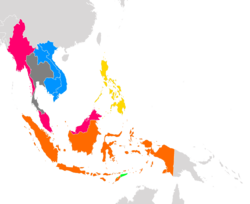
Back الاستعمار الأوروبي لجنوب شرق آسيا Arabic দক্ষিণ-পূব এছিয়াত ইউৰোপীয় উপনিৱেশীকৰণ Assamese استعمار اروپا در جنوب شرقی آسیا Persian Penjajahan Eropah di Asia Tenggara Malay

of Southeast Asia
The first phase of European colonization of Southeast Asia took place throughout the 16th and 17th centuries. Where new European powers competing to gain monopoly over the spice trade, as this trade was very valuable to the Europeans due to high demand for various spices such as pepper, cinnamon, nutmeg, and cloves. This demand led to the arrival of Portuguese, Spanish, Dutch, French, and British marine spice traders. Fiercely competitive, the Europeans soon sought to eliminate each other by forcibly taking control of the production centres, trade hubs and vital strategic locations, beginning with the Portuguese acquisition of Malacca in 1511. Throughout the 17th and 18th centuries, conquests focused on ports along the maritime routes, that provided a secure passage of maritime trade. It also allowed foreign rulers to levy taxes and control prices of the highly desired Southeast Asian commodities.[1] By the 19th century, all of Southeast Asia had been forced into the various spheres of influence of European global players except Siam, which had served as a convenient buffer state sandwiched between British Burma and French Indochina. The kings of Siam had to contend with repeated humiliations, accept unequal treaties among massive French and British political interference and territorial losses after the Franco-Siamese crisis of 1893 and the Anglo-Siamese Treaty of 1909.[2][3][4]
The second phase of European colonisation of Southeast Asia is related to the Industrial Revolution and the rise of powerful nation states in Europe. As the primary motivation for the first phase was the mere accumulation of wealth, the reasons for and degree of European interference during the second phase are dictated by geostrategic rivalries, the need to defend and grow spheres of interest, competition for commercial outlets, long term control of resources and the Southeast Asian economies becoming more closely tied to European industrial and financial affairs by the late 19th century.[5][6]
- ^ "About the Silk Road". Unesco. Retrieved 13 December 2018.
- ^ LePoer, Barbara Leitch, ed. (1987). "The Crisis of 1893". Thailand: A Country Study. Library of Congress. Retrieved 14 December 2018.
- ^ Aloysius Ng. "Empire in Asia". National University of Singapore. Retrieved 14 December 2018.
- ^ Paget, Ralph; Varoprakar, Devawongse (1909). "Treaty between Great Britain and Siam". The American Journal of International Law. 3 (4): 297–304. doi:10.2307/2212641. JSTOR 2212641. S2CID 246007886.
- ^ "Patterns Of A Colonial Age". Encyclopedia britannica. Retrieved 13 December 2018.
- ^ "Colonial History of Southeast Asia". Slide Share. 8 November 2011. Retrieved 13 December 2018.